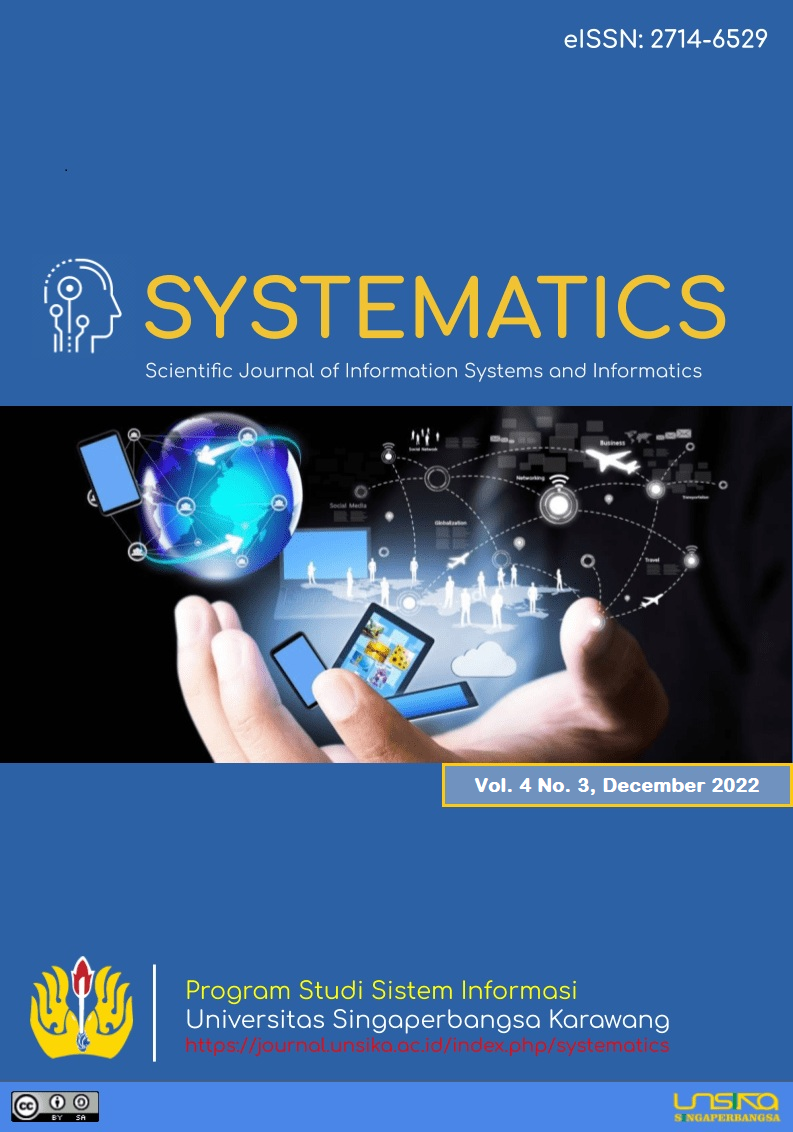Fi’il Mu’tal Pattern Detection System In The Image Of The Qur’an Using The Sokal & Michener Method
Sistem Deteksi Pola Fi'il Mu'tal Pada Citra Al-Qur'an Menggunakan Metode Sokal & Michener
DOI:
https://doi.org/10.35706/sys.v4i3.7832Abstract
The book of the Qur'an is Kalamullah, as a miracle, which has been revealed to the closing of the Prophets and Apostles, Muhammad through the intermediary of Jibril which is contained in his manuscripts, reads it as worship, which begins with Surah Al-Fatihah which closes with Surah An-Nas. To read from the contents of the verses of the Qur'an, knowledge and understanding are needed in understanding the contents of the contents of the verses of the Qur'an. By learning the science of nahwu, we can find out every meaning of the verses of the Qur'an. In general, not many people study and do not easily understand and seek every meaning of the Qur'an. Therefore, an application for detection of the Qur'an was made entitled System of Detecting Fi'il Mu'tal Patterns in Al-Qur'an Imagery Using the Sokal & Michener Method and from the test results that the accuracy of this system gets a value of 96%. The percentage detection rate indicates that the Sokal & Michener can be used as a detector in the image pattern of the Qur'anic verse. This system has been tested, it can be seen in the performance of this Fi'il Mu'tal Pattern detection system, the accuracy process is carried out by providing training training with many and variedThis Fi'il detection system helps in learning the meaning of words in the Qur'an, and this application is needed for beginners who want to get more knowledge from everything that is learned from this application, teacher guidance is needed to guide in learning how to interpret words or content according to the true laws.
Downloads
References
Sholehudin, A. F. Huda, D. Restiani, and D. I. S. Saputra, “Proses digitalisasi citra analog menggunakan aplikasi pengolah citra digital,” Semin. Nas. Teknol. Inf. dan Multimed. 2017, pp. 13–18, 2017.
Y. Setiyawan, “Perancangan Dan Analisis Sistem Pengenalan Kata Aksara Sunda Menggunakan Metode Learning Vector Quantization Berbasis Pengolahan Citra,” vol. 4, no. 1, pp. 1–14, 2017.
M. Maryana, F. Fadlisyah, and S. Retno, “Pendeteksi Tajwid Idgham Mutajanisain Pada Citra Al-Qur’an Menggunakan Fuzzy Associative Memory (FAM),” TECHSI-Jurnal Tek. …, 2017, [Online]. Available: https://ojs.unimal.ac.id/techsi/article/view/216
S. Suhendri and P. Rahayu, “Metode Grayscale Co-occurrence Matrix (GLCM) Untuk Klasifikasi Jenis Daun Jambu Air Menggunakan Algoritma Neural Network,” J. Inf. Technol., vol. 1, no. 1, pp. 15–22, 2019, doi: 10.47292/joint.v1i1.4.
F. Jayapura et al., “Sistem Pendeteksi Pola Tajwid Al-Qur ’ an Hukum Mad Thabi ’ I Menggunakan Metode Sokal & Michener,” vol. 255, no. November, pp. 2–7, 2017.
N. Nurdin, D. Hamdhana, and M. J. Setiawan, “Sistem Pendeteksi Pola Lafadz Allah Dan Muhammad Pada Citra Al-Qur’an Menggunakan Metode Peirce,” TECHSI - J. Tek. Inform., vol. 9, no. 2, p. 78, 2017, doi: 10.29103/techsi.v9i2.215.
R. L. Mariany Siagian, Mohammad Basyun, “Kajian Strategi Pengembangan Ekowisata Mangrove Di Pesisir Sei Nagalawan Kecamatan Perbaungan Kabupaten Serdang Bedagai Sumatera Utara,” Concept Commun., vol. null, no. 23, pp. 301–316, 2019.
M. Brusco, J. Dennis Cradit, and D. Steinley, “A comparison of 71 binary similarity coefficients: The effect of base rates,” PLoS One, vol. 16, no. 4 April, pp. 1–19, 2021, doi: 10.1371/journal.pone.0247751.
U. P. Indonesaia, “Teori skema”.
I. G. T. Isa and G. P. Hartawan, “Perancangan Aplikasi Koperasi Simpan Pinjam Berbasis Web (Studi,” J. Ilm. Ilmu Ekon., vol. 5, no. 10, pp. 139–151, 2017.
Downloads
Published
How to Cite
Issue
Section
License
Copyright (c) 2022 SYSTEMATICS

This work is licensed under a Creative Commons Attribution-ShareAlike 4.0 International License.
Authors who publish with this journal agree to the following terms:
- Authors retain copyright and grant the journal right of first publication with the work simultaneously licensed under a Creative Commons Attribution-ShareAlike 4.0 International License. that allows others to share the work with an acknowledgement of the work's authorship and initial publication in this journal.
- Authors are able to enter into separate, additional contractual arrangements for the non-exclusive distribution of the journal's published version of the work (e.g., post it to an institutional repository or publish it in a book), with an acknowledgement of its initial publication in this journal.
- Authors are permitted and encouraged to post their work online (e.g., in institutional repositories or on their website) prior to and during the submission process, as it can lead to productive exchanges, as well as earlier and greater citation of published work (See The Effect of Open Access).







